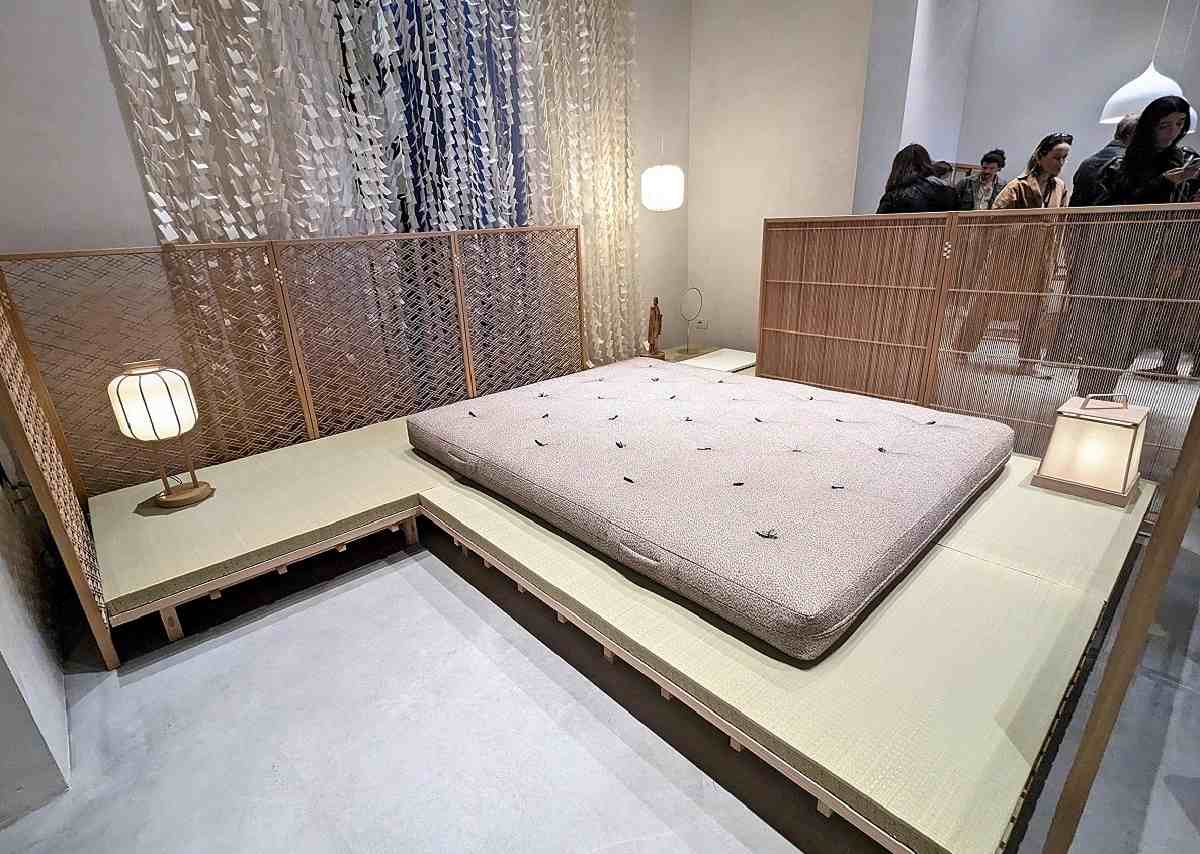
A Time & Style modular furniture item using tatami mats
13:30 JST, August 11, 2024
Japanese luxury brand furniture using igusa rush grass — the raw material of tatami mats — is attracting attention overseas.
Furniture made from igusa is gradually becoming popular in Japan, as evidenced by its introduction in high-end Japanese inns. Awareness of such furniture is still low overseas, but domestic manufacturers are promoting the advantages of and design possibilities of the natural material.
At Salone del Mobile.Milano, the world’s largest international furniture fair, held in Italy in April, Fukuoka Prefecture-based Adal Co., a manufacturer of business furniture, exhibited a chair made with igusa.

German designer Michael Geldmacher sits on a chair made with igusa rushes in Italy in April
German designer Michael Geldmacher designed the chair after being inspired by the undulating shape of dunes and used igusa to make it.
Geldmacher said there is a lot of interest in natural materials in Europe. He was drawn to igusa as a material for furnitures, he said. The chair has been well received, winning an international design award in Germany this year.
Igusa production in Japan has shrunk by about 80% over the past 20 years for reasons including a decline in the number of Japanese-style rooms and the rise of cheap foreign igusa.
Adal established the Look into Nature brand furniture using igusa in 2019. The firm manufactures sofas and stools as well.
“We want to support igusa producers,” brand manager Kenji Hadama said.
Igusa chairs at inns
Chairs made of the traditional material have been supplied to some luxury inns in Japan.
At Seijyakubow, an inn that opened in 2022 on the Tokachi Plain in Hokkaido, Adal’s benches and lounge chairs made with igusa are placed in the lobby and other areas.
“Furniture made of igusa brings a sense of freedom not felt in everyday life. Customers are often surprised by furniture made from igusa, and the scent of the igusa is also popular,” Seijakubow representative Keiji Ishimura said.
Tatami mats made of domestic igusa are also part of a modular furniture item presented in Milan by Time & Style, which has a factory in Hokkaido.
The furniture is based on sunoko, a low-to-the-floor wooden platform of the type sometimes used to support a futon. Made of Akita cedar, the furniture’s sunoko can be arranged in various ways to support cushions or tatami depending on the wishes and needs of the user.
“This item can be used to create a small tatami room space. It can also be used as a bed or sofa in combination with a mattress,” an official of the firm said.
The firm also displayed the furniture at an interior design event held in Tokyo in June.
Danielle Demetriou, a British journalist living in Japan who is well versed in interior design, said that although tatami is well known in Europe, much less is known about the material used to make it.
However, Europeans have traditionally woven the plant and used it for interior decor items such as baskets, chair seats and rugs.
“I think people need to know more about the beauty and stories and values that underpin igusa — the scenic regions in Japan where it grows the painstaking generations-old skills and techniques of igusa craftsmanship,” Demetriou said.
“On a practical level, igusa’s potential values in modern Western life, in terms of both design and functions, also need to be highlighted: for example, its high durability and its ability to moderate interior humidity levels through absorbing moisture.”
"Society" POPULAR ARTICLE
-

Fire Damages 170 Buildings in Oita, Western Japan
-

Tatsuya Nakadai, Japanese Actor, Dies at 92; Appeared in Films Including “The Human Condition” and “Ran” (UPDATE 1)
-

M5.7 Earthquake Hits Japan’s Kumamoto Pref., Measuring Upper 5 Intensity, No Tsunami Expected
-

Beloved Cat Stationmaster Nitama in Wakayama Pref. Passes Away at 15
-

No Easy Fix for Tokyo’s Soaring Real Estate Prices
JN ACCESS RANKING
-

Govt Plans to Urge Municipalities to Help Residents Cope with Rising Prices
-

Essential Services Shortage to Hit Japan’s GDP By Up to ¥76 Tril. By 2040
-

Japan Prime Minister Takaichi Vows to Have Country Exit Deflation, Closely Monitor Economic Indicators
-

Japan to Charge Foreigners More for Residence Permits, Looking to Align with Western Countries
-

Japan GDP Down Annualized 1.8% in July-Sept.






















